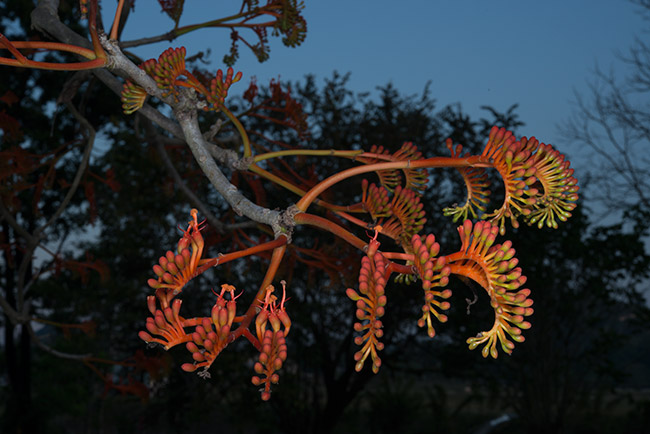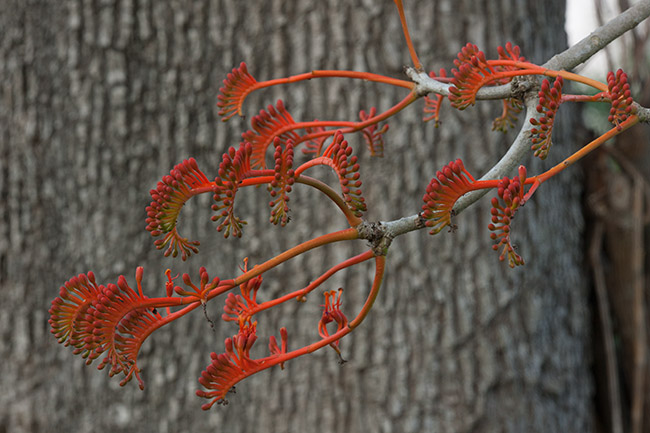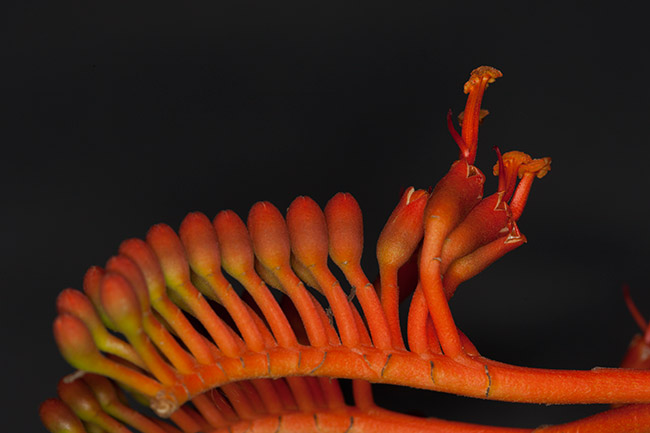This tree is a relative of the Ceiba (the leaves are especially reminiscent). The flowers are remarkable: totally different in all visual aspects from any other subfamily Bombacoideae.
The seeds have a "wing" which makes a single seed look like the wing of a cockroach. So one name for this tree is ala de cucaracha. Like most trees and plants in Latin America, this tree has different names depending on where you are or who you are speaking with.
This tree is worth studying by botanists, ethnobotanists, and all people who wish to learn about the world that the Maya lived in. Most of the traditional botanical information was over half a century ago.
STANDLEY, Paul C. and Julian A. STEYERMARK
1949 Flora of Guatemala. Fieldiana, Botany, Vol. 24, Part VI. Chicago Natural History Museum.
Mapola, Bernoullia flammea, taken at "El Chal" on March 2013.
Bernoullia flammea Oliver in Hook. Icon. PI. 12: 62. pis. 1169, 1170. 1873. Uacut (Peten); Cante; Ala de cucaracha.
Type collected at Ixtacapa, Suchitepequez, Bernoulli 553. Occasional in the rather dry (during the winter months) forest of the higher plains and lower foothills of Retalhuleu (San Felipe and elsewhere) and Suchitepequez; Peten. Oaxaca; British Honduras; Atlantic coast region of Honduras.
A large or medium-sized tree, sometimes 30 meters tall with a trunk a meter in diameter, the bark brown, the trunk tall, the crown somewhat depressed and spreading; leaflets usually 5-6, sometimes only 3, oblong-oblanceolate, 10-22 cm. long, acute or acuminate, cuneate-attenuate to the base, thin, green, almost or quite glabrous; whole inflorescence bright red or orange-red, sparsely puberulent, the flowers long-pedicellate; calyx 1 cm. long, shallowly lobate; petals recurved; stamen tube long-exserted, the anthers clustered at its apex; fruit very hard, attenuate to each end, about 20 cm. long, glabrous within; seeds, including the long wing, about 5 cm. long.
Called "mapola" in British Honduras (a corruption of "amapola"); known in Oaxaca as "palo calabaza" and "palo de perdiz."
Mapola, Bernoullia flammea, taken at "El Chal" on March 2013.
The wood is described as soft and spongy. We have seen very few individuals of this species. It is said to be common in the vicinity of San Sebastian, Retalhuleu, but we have seen only a few trees apparently planted in the fincas, and of only medium size. The trees are leafless during at least the latter part of the dry season and are said to open their flowers at the beginning of the rainy season.
The bright red flowers are very showy. The seeds are stated to be edible.
(Standley and Steyermark 1949: 387-388)
Bernoullia flammea Oliver. Mapola. Collected at several localities; Oaxaca to Guatemala and Honduras. A large tree as much as 30 meters high, with a trunk 90 cm. in diameter; leaflets 5-6, oblong-oblanceolate, 10-22 cm. long, acuminate, glabrous; inflorescence bright fire-red; calyx 1 cm. long; petals recurved; stamen tube long-exserted; fruit brown, ellipsoid, woody, 20 cm. long.
Seeds winged; flowers in one-sided racemes Bernoullia. (Standley and Record 1936:248)
The Forests and Flora of British Honduras.
3. BERNOUXLIA Oliver in Hook. Icon. PI. 12: 62. 1873.
1. Bernoullia flammea Oliver in Hook. Icon. PI. 12: 62. pi. 1169, 1170. 1873.
Oaxaca. Type from " Costa Grande," Guatemala.
Tree, sometimes 40 meters high, with broad crown; leaflets usually 5 or 6, oblong-oblanceolate, petiolulate, 10 to 22 cm. long, acute or acuminate, glabrous whole inflorescence bright red, obscurely puberulent; calyx 1 cm. long, shallowly bilobate; petals recurved; stamen tube long-exserted, the anthers clustered at the apex; fruit brown, ellipsoid, 20 cm. long, glabrous within; seeds (including the long wing) about 5 cm. long. " Palo calabaza," " palo de perdiz " (Oaxaca).
The wood is described as soft and spongy.
(Standley 1923:788).
Trees and Shrubs of Mexico, Vol. 23, Part 3
Now we can add Tikal and El Chal (Peten)
to where to find Bernoullia flammea
The traditional botanical documentation does not include most of the Lowland Maya heartland. But how that you can easily see many Bernoulia flammea trees in the main areas of Tikal, this location can be added.
There are also two beautiful examples just outside the northern city limits of El Chal, a several hour drive south of Tikal (on the highway towards Poptun). A local hotel owner said there were many Bernoullia flammea trees on his property near Dolores (Peten). But most are being chopped down for lumber.
Mapola, Bernoullia flammea, taken at "El Chal" on March 2013.
The common local name(s) for Bernoullia flammea
Cante' is a common name listed by Listado de las Principales Especies Forestales de Guatemala. The problem with this name (Cante', which means can che' or kan che', yellow tree) is that many totally unrelated trees have the same name, especially in the Popol Vuh.
Cante is also the name for Caesalpinia violacea (www.fao.org/docrep/006/ad402s/ad402s04.htm).
Canté is also the name for madre de cacao (Mata Raton), Gliricidia sepium. Tedlock accepts this name for the tree in the Popol Vuh. However these are small trees, not the kind that monkeys would prefer. Christenson does not identify the tree by any species or any name whatsoever.
Since the tree's flowers are orange, and nowhere near yellow, I am not convinced by the name "yellow tree."
In Highland Chiapas the trees names include Cosanté Palo de cuesa, Palo de tortilla, Palo de calabaza, Palo de corcho, Palo de perdiz (Ordenamiento Ecológico Comunitario "NUEVO PARAISO, MUNICIPIO DE PANTELHÓ, CHIAPAS" Julio-Septiembre de 2007).
In order to avoid calling the tree "cocaine" (amapola), and to avoid using an Anglicized name, Mapola, I have selected Cosante, Uacut, or ala de cucaracha (cockroach wing) which is a good description of the seed.
First posted April 2015
After finding two impressive Bernoullia flammea trees blooming near El Chal, Peten.
















































































